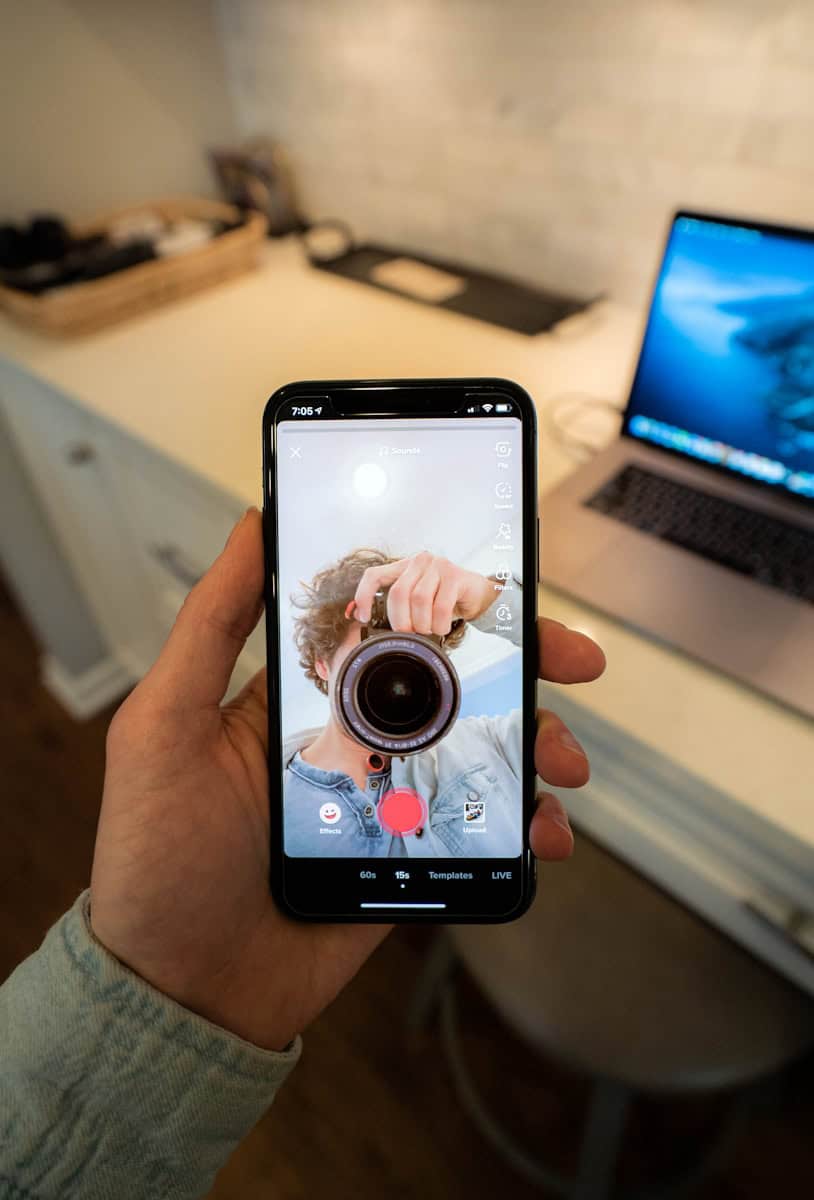Taking selfies on your iPhone just got better. The Mirror Front Camera feature lets you capture selfies that match the preview you see on screen. You can now snap photos that look exactly like what you see in the Camera app before taking the shot.
This small change makes a big difference. It helps you frame your selfies more easily and avoid surprises when viewing your photos later. The mirrored image feels more natural, as it’s how you’re used to seeing yourself in a mirror.
To use this feature, you just need to toggle a simple setting in your iPhone’s Camera preferences. Once enabled, your selfies will match the preview image every time. This works for both still photos and videos taken with the front camera.
| Feature | Without Mirror | With Mirror |
|---|---|---|
| Image | Flipped horizontally | Matches preview |
| Text in photo | Reversed | Readable |
| Familiarity | Less natural | More natural |
| Framing | May be off | Easier to compose |
Mirror, Mirror: Perfecting Your iPhone Selfies
Have you ever noticed that your selfies sometimes look different than you expect? That’s because your iPhone camera flips the image by default, creating a mirrored version of yourself. While this might seem like a minor detail, it can significantly impact how your selfies turn out. But don’t worry, there’s an easy fix!
Understanding the Mirroring Effect
When you take a selfie with your iPhone, the camera app automatically flips the image horizontally. This is done to create a more natural viewing experience, as it mimics how you see yourself in a mirror. However, this mirrored image isn’t how others see you. It can make features appear reversed, like a parting in your hair on the “wrong” side or a birthmark appearing on the opposite cheek. This can be disorienting and might make you feel like your selfies don’t truly represent you.
Turning Off Mirroring
The good news is you can easily turn off mirroring in your iPhone’s camera settings. Here’s how:
- Open the Settings app.
- Scroll down and tap on Camera.
- Toggle the switch next to Mirror Front Camera to the off position.
Now, when you take a selfie, the photo will be saved as you see yourself in the preview, without being flipped. This can help your selfies look more natural and true to life.
Adjusting to the Unmirrored View
It might take a little time to get used to seeing yourself unmirrored in selfies. Our brains are accustomed to the mirrored version, so the unmirrored image might initially feel a bit strange. But with a little practice, you’ll start to appreciate the more accurate representation of yourself.
Mirroring and Your iPhone Selfies:
| Setting | Effect |
|---|---|
| Mirror Front Camera ON | Selfies are flipped horizontally, mimicking a mirror image. |
| Mirror Front Camera OFF | Selfies are saved as they appear in the preview, without being flipped. |
Understanding the iPhone Front Camera
Selfies have become a ubiquitous part of our digital lives. We snap them to capture memories, express ourselves, and share moments with friends. But have you ever stopped to think about how your iPhone’s camera affects your selfies? There’s a hidden setting that can make a big difference in how your photos turn out.
The iPhone’s front camera has evolved significantly over the years. It now offers advanced features and improved image quality for selfies and video calls.
Front Camera Specifications and Hardware
The latest iPhone models boast impressive front camera hardware. The iPhone 13 Pro and Pro Max feature a 12-megapixel TrueDepth camera system. This camera includes advanced capabilities like Night mode and ProRes video recording.
Key features of the front camera include:
- f/2.2 aperture for better low-light performance
- Retina Flash for improved selfies in dim settings
- 4K video recording at up to 60 fps
- Cinematic mode for videos with shallow depth of field
The TrueDepth system also powers Face ID. It uses infrared and dot projection technology to create a detailed 3D map of your face for secure authentication.
Evolution Across iPhone Models
Front camera technology has come a long way since the first iPhone. Early models had basic VGA-quality front cameras primarily for video calls. Today’s iPhones offer studio-quality selfies and advanced video features.
Notable improvements include:
| iPhone Model | Front Camera Resolution | Key Features |
|---|---|---|
| iPhone 4 | 0.3 MP | First with front camera |
| iPhone 6 | 1.2 MP | Introduced Retina Flash |
| iPhone X | 7 MP | TrueDepth camera, Face ID |
| iPhone 13 Pro | 12 MP | Night mode, Cinematic mode |
Recent advancements focus on computational photography. This allows for features like Portrait mode selfies with adjustable depth of field and Smart HDR for improved dynamic range.
Mirror Front Camera Feature
The Mirror Front Camera feature on iPhones allows you to capture selfies that match your mirror reflection. This tool impacts how you take and view photos using your device’s front-facing camera.
Concept of Mirrored vs. True-to-Life Photos
Mirrored selfies reflect what you see when looking in a mirror. This view feels natural as it’s how you typically see yourself.
True-to-life photos show how others see you. These images appear flipped compared to your mirror image.
The Mirror Front Camera setting lets you choose between these two options. It affects how your selfies look when saved to your camera roll.
Understanding this difference helps you decide which style you prefer for your photos.
Functionality and Impact on Selfies
With Mirror Front Camera on, your selfies match your mirror reflection. This can make posing feel more intuitive.
When off, photos show the non-mirrored view. This might look strange to you but normal to others.
The setting affects only photos taken with the front camera. It doesn’t change how you appear in the camera app preview.
| Mirror Front Camera | Image Saved | How You See It | How Others See It |
|---|---|---|---|
| On | Mirrored | Natural | Flipped |
| Off | True-to-life | Flipped | Natural |
This feature can impact how you frame your shots and pose for selfies.
Navigating Camera Settings for Mirror Mode
To use this feature, you need an iPhone XS or newer running iOS 14 or later.
Access the Mirror Front Camera setting by opening your iPhone’s Settings app. Scroll down and tap “Camera”.
Look for the “Composition” section. You’ll find a toggle switch labeled “Mirror Front Camera”.
Turn the switch on to enable mirrored selfies. Turn it off for true-to-life photos.
You can change this setting at any time. Your iPhone will remember your preference until you change it again.
iOS Influence on Camera Functions
Apple’s iOS updates have significantly enhanced iPhone camera capabilities. These changes improved user experience and introduced innovative features for capturing and editing photos.
Changes Brought by iOS 14 Update
iOS 14 revolutionized iPhone camera functions. It introduced the Mirror Front Camera feature, allowing you to see yourself as you do in a mirror when taking selfies. This setting is easy to toggle in the Camera settings.
The update also added an exposure compensation control to the camera app. This tool lets you adjust image brightness before taking a photo. It’s particularly useful in challenging lighting conditions.
iOS 14 improved Night mode for selfies on compatible devices. This enhancement allows for better low-light self-portraits without the need for flash.
Introduction of New Features in iOS 17
iOS 17 built upon previous improvements, refining existing features and adding new ones. The update brought enhanced AI-powered photo editing tools to the Photos app. These tools make it easier to adjust lighting, color, and composition.
A standout addition is the new Focus mode for portrait photos. This feature creates a more precise depth-of-field effect, resulting in professional-looking portraits.
iOS 17 also improved video stabilization in the camera app. This upgrade helps you capture smoother footage without additional equipment.
| Feature | iOS 14 | iOS 17 |
|---|---|---|
| Mirror Front Camera | Introduced | Refined |
| Exposure Control | Added | Enhanced |
| Night Mode Selfies | Improved | Further optimized |
| AI Photo Editing | Basic | Advanced |
| Focus Mode | Not available | Introduced |
| Video Stabilization | Standard | Improved |
Practical Usage and Sharing of Selfies
The iPhone’s mirror front camera feature enhances selfie-taking and sharing. It offers editing options and seamless integration with popular social media platforms.
Photo Editing and Storage Options
After taking a mirrored selfie, you can edit it directly in the Photos app. Tap “Edit” and use tools like crop, filters, and adjustments to perfect your image. The Photos app automatically organizes selfies into albums, making them easy to find.
You can also use third-party photo editing apps for more advanced features. These apps often offer specialized tools for portrait retouching and creative effects.
To save storage space, enable iCloud Photos. This feature uploads your selfies to the cloud, freeing up local storage while keeping your photos accessible across all your devices.
Integration with Social Media and Messaging Apps
Sharing mirrored selfies on social media is straightforward. Most apps like Instagram, Facebook, and Twitter integrate directly with your iPhone’s photo library. You can post selfies without leaving the app.
For messaging, iMessage and FaceTime allow quick selfie sharing. Simply tap the camera icon in these apps to take and send a mirrored selfie instantly.
| App | Selfie Features |
|---|---|
| Filters, Stories, Direct Messages | |
| iMessage | Stickers, Effects, Memoji |
| FaceTime | Live selfies during calls |
Remember, some apps may flip your mirrored selfie when posting. Check your app’s settings to ensure your selfie appears as intended.
Frequently Asked Questions
The mirror front camera feature on iPhones offers users control over how selfies appear. This section addresses common queries about enabling, using, and troubleshooting this function across different iPhone models.
How do I enable or disable the mirror front camera feature on my iPhone?
You can easily toggle the mirror front camera setting. Go to Settings > Camera > Mirror Front Camera. Tap the switch to turn it on or off. This setting is available on iPhone XS and newer models with iOS 14 or later.
What does the mirror front camera setting do on an iPhone?
The mirror front camera setting affects how your selfies are captured and stored. When turned on, it saves the image as you see it in the preview. This mirrors how you appear when looking at yourself in a mirror. When off, the photo is flipped horizontally.
Is there a way to take a selfie without pressing the button on my iPhone?
Yes, you can use alternative methods to capture selfies. Try using the volume buttons on your iPhone or connected headphones. You can also enable voice control to take photos hands-free. These options work well with the mirror front camera feature.
How can I correct issues with the mirror front camera not working on my iPhone?
If you’re experiencing problems, try these steps:
- Ensure your iPhone model supports the feature
- Update to the latest iOS version
- Restart your iPhone
- Reset camera settings
If issues persist, contact Apple Support for further assistance.
Are photos taken with the mirror front camera considered to have a better appearance?
The preference for mirrored or non-mirrored selfies is subjective. Some users find mirrored photos more natural as they match what they see in the preview. Others prefer the traditional flipped image. Experiment to find your preference.
What are the differences in using the mirror front camera on various iPhone models, such as the iPhone 13 Pro Max?
While the mirror front camera feature works similarly across supported models, newer iPhones may offer additional selfie-enhancing features. The iPhone 13 Pro Max, for example, has improved low-light performance and advanced computational photography. These enhancements work in tandem with the mirror front camera option.
| iPhone Model | Mirror Front Camera Support | Additional Selfie Features |
|---|---|---|
| iPhone XS and newer | Yes | Varies by model |
| iPhone X and older | No | Limited |







